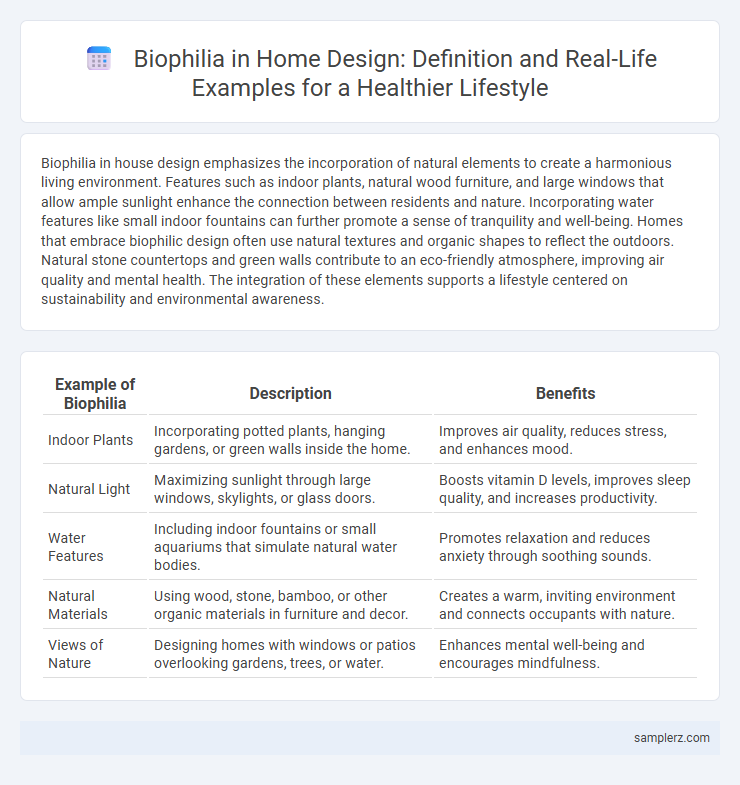Biophilia in house design emphasizes the incorporation of natural elements to create a harmonious living environment. Features such as indoor plants, natural wood furniture, and large windows that allow ample sunlight enhance the connection between residents and nature. Incorporating water features like small indoor fountains can further promote a sense of tranquility and well-being. Homes that embrace biophilic design often use natural textures and organic shapes to reflect the outdoors. Natural stone countertops and green walls contribute to an eco-friendly atmosphere, improving air quality and mental health. The integration of these elements supports a lifestyle centered on sustainability and environmental awareness.
Table of Comparison
| Example of Biophilia | Description | Benefits |
|---|---|---|
| Indoor Plants | Incorporating potted plants, hanging gardens, or green walls inside the home. | Improves air quality, reduces stress, and enhances mood. |
| Natural Light | Maximizing sunlight through large windows, skylights, or glass doors. | Boosts vitamin D levels, improves sleep quality, and increases productivity. |
| Water Features | Including indoor fountains or small aquariums that simulate natural water bodies. | Promotes relaxation and reduces anxiety through soothing sounds. |
| Natural Materials | Using wood, stone, bamboo, or other organic materials in furniture and decor. | Creates a warm, inviting environment and connects occupants with nature. |
| Views of Nature | Designing homes with windows or patios overlooking gardens, trees, or water. | Enhances mental well-being and encourages mindfulness. |
Embracing Nature: Biophilic Design in Modern Homes
Incorporating biophilic design in modern homes involves integrating natural elements such as indoor plants, natural light, and organic materials like wood and stone to create a harmonious living environment. Features like living green walls, large windows with views of greenery, and water features enhance connection to nature, promoting well-being and reducing stress. Embracing nature through biophilia optimizes air quality and boosts mental health, making it a crucial aspect of contemporary lifestyle design.
Incorporating Indoor Plants for Healthier Living Spaces
Incorporating indoor plants like snake plants and peace lilies enhances air quality by reducing pollutants such as formaldehyde and benzene, promoting healthier living spaces. Studies show that biophilic design elements, including greenery, can lower stress levels and improve mental well-being. Strategically placing plants near workspaces or common areas maximizes their natural benefits, creating a nurturing and vibrant home environment.
Natural Light: Maximizing Sunlight in Home Interiors
Maximizing natural light in home interiors enhances biophilic design by creating a seamless connection to the outdoors and improving well-being. Large, strategically placed windows and skylights allow abundant sunlight to penetrate deep into living spaces, reducing reliance on artificial lighting and promoting circadian rhythm regulation. Incorporating reflective surfaces and light-colored walls further amplifies sunlight distribution, fostering a bright, inviting atmosphere that supports a healthy lifestyle.
Using Organic Materials for a Biophilic Touch
Incorporating organic materials such as bamboo, reclaimed wood, and natural stone into home interiors enhances the biophilic connection by promoting sustainability and natural aesthetics. These materials improve indoor air quality and create a tactile, warm atmosphere that mimics outdoor environments. Using organic textiles like cotton and wool further enriches the sensory experience, fostering a deeper connection to nature within the living space.
Creating Green Walls and Vertical Gardens Indoors
Creating green walls and vertical gardens indoors enhances air quality by incorporating live plants that filter toxins and increase oxygen levels. These installations maximize limited space and bring natural textures into living areas, promoting mental wellbeing and reducing stress. Integrating diverse plant species such as ferns, succulents, and pothos contributes to biodiversity and a visually dynamic environment.
Blurring Boundaries: Bringing the Outdoors Inside
Incorporating natural elements such as living green walls, large floor-to-ceiling windows, and indoor water features blurs boundaries between indoor and outdoor spaces, enhancing biophilia in the home. Using organic materials like reclaimed wood and stone emphasizes a seamless connection to nature, fostering tranquility and well-being. This approach not only improves air quality but also creates a sensory experience that strengthens the occupant's bond with the natural environment.
Water Features: Adding Calmness and Serenity at Home
Incorporating water features such as indoor fountains or small cascading waterfalls enhances biophilic design by introducing natural sounds that promote relaxation and reduce stress. These elements increase humidity and improve air quality, creating a healthier indoor environment while providing a visual connection to nature. The soothing presence of flowing water fosters calmness and serenity, making living spaces more inviting and restorative.
Natural Color Palettes for a Relaxing Atmosphere
Natural color palettes in interior design, featuring earthy tones such as soft greens, warm browns, and muted beiges, enhance biophilia by creating a calming and grounding atmosphere in the home. Incorporating these colors through paint, furniture, and decor elements fosters a seamless connection with nature, promoting relaxation and reducing stress. Houseplants, wooden accents, and stone textures complement these palettes, amplifying the soothing ambiance and supporting mental well-being.
Designing with Views: Optimizing Outdoor Connections
Designing with views enhances biophilic homes by maximizing natural sightlines to gardens, forests, or water features, creating seamless indoor-outdoor connections. Large floor-to-ceiling windows and sliding glass doors integrate the exterior environment, promoting wellbeing through constant visual access to nature. Strategic placement of living spaces toward scenic vistas increases natural light exposure and fosters a calming atmosphere that supports mental health.
Sustainable Furniture for Eco-Friendly Living
Sustainable furniture crafted from reclaimed wood and natural materials exemplifies biophilia by integrating organic elements into home design, promoting environmental responsibility and well-being. Furniture pieces made from bamboo, cork, and recycled metals reduce carbon footprints while enhancing indoor air quality and connecting residents with nature. Incorporating eco-friendly upholstery with non-toxic dyes further supports a healthy, sustainable living environment aligned with biophilic principles.

example of biophilia in house Infographic
 samplerz.com
samplerz.com